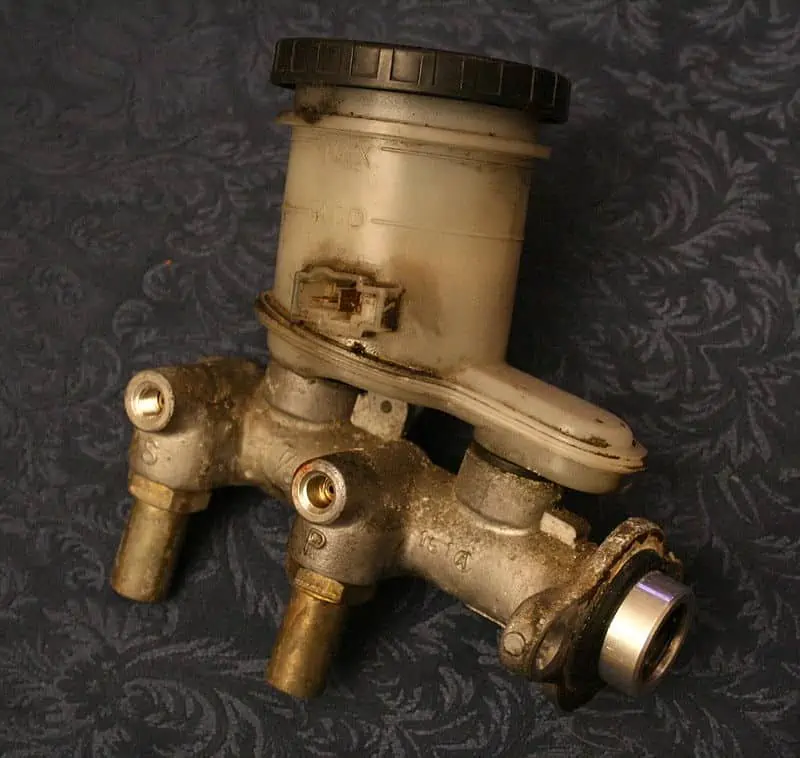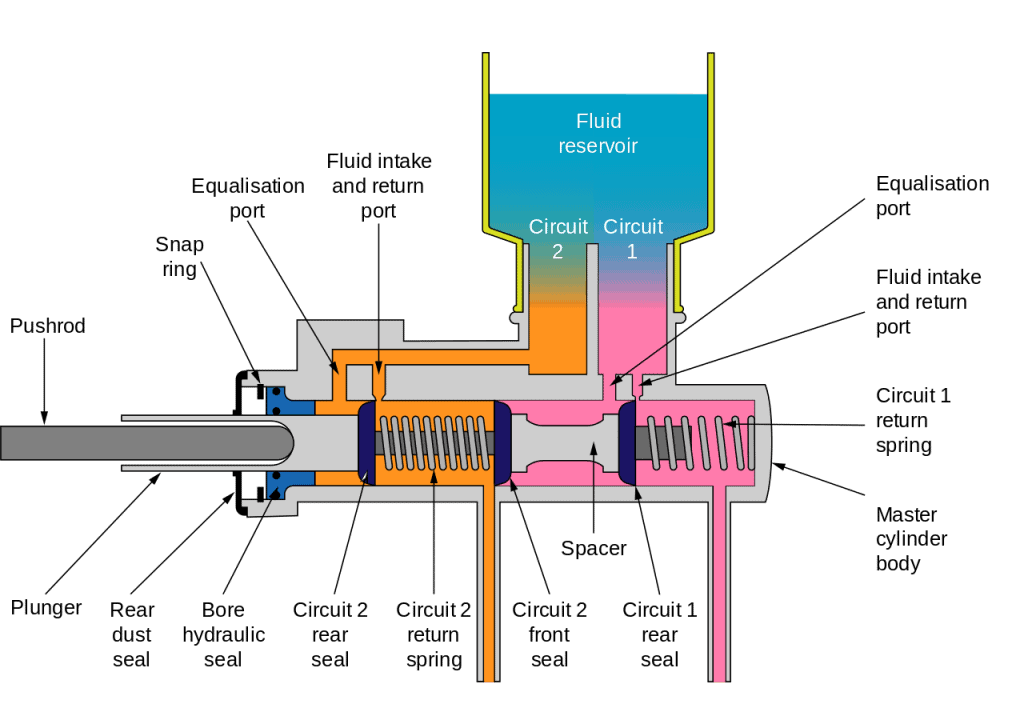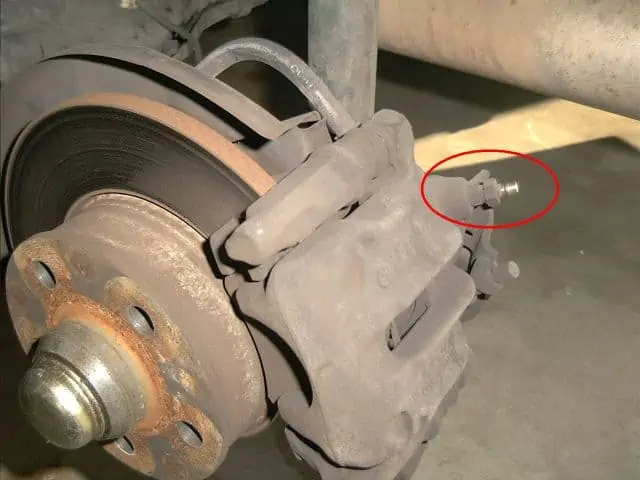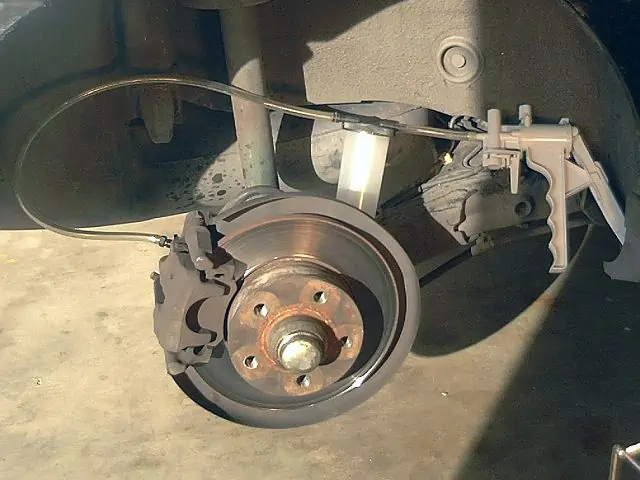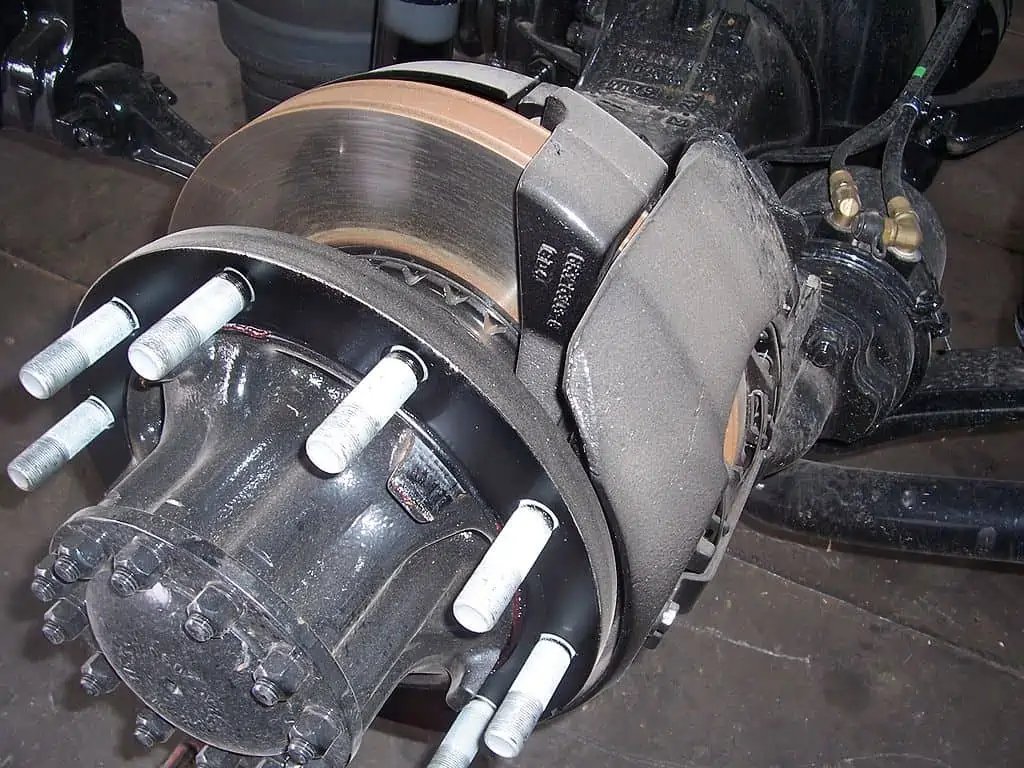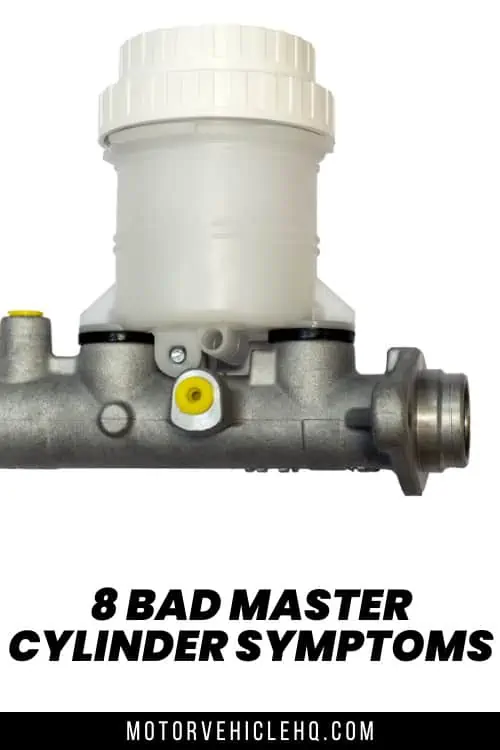Modern automobiles come with what traditional technicians refer to as “power brakes.” The brake booster and master cylinder, often known as the “Vacuum brake servo,” make up the system.
Their responsibility is to increase the amount of brake pedal pressure. This makes it possible for you to gently regulate the brakes as you slow down. In an emergency, the system will also increase braking force.
Having said that, it’s crucial to pay attention to your car’s brakes. If either the brake booster or master cylinder malfunctions, a contemporary braking system will stop functioning.
The firewall on the driver’s side holds the brake booster. The booster is split between the front engine side and the rear driver side chambers on the interior by a flexible diaphragm.
The front chamber of the booster is connected to the intake manifold by a substantial, flexible rubber line. To enhance the sensation of the brake pedal, the engine will supply vacuum pressure within the booster.
A power piston or push rod that is also attached to the booster’s center is connected to the brake pedal. The master cylinder is directly attached to the opposite end of the piston, which controls several valves.
when applying the brakes. To allow the pressure within the chamber, the middle valve and the rear valve will either open or close. To provide braking pressure, the pressure will force hydraulic fluid or brake fluid to the brake calipers.
The symptoms of a faulty brake master cylinder, however, might be strange and not always easy to identify. Here are several indicators to watch for:
Having a mushy or sinking brake pedal is the most typical sign of a damaged brake master cylinder. Additionally, you can see decreased braking power or, in the worst-case scenario, no brakes at all. Brake fluid on the ground might potentially indicate a malfunctioning brake master cylinder.
Yes, despite their seeming simplicity, the brake booster and master cylinder are intricate mechanical components. The most typical signs of a damaged brake master cylinder are listed in further detail in this article:
A Master Cylinder: What Is It?
A contemporary disc braking system has multiple parts, including a master cylinder, brake pads, a caliper, and a rotor.
The master cylinder releases pressurized brake fluid into the caliper once you depress the brake pedal. After that, the caliper presses the pads up against the rotor, causing friction and delaying the spinning of the wheel.
As you can see, the caliper gets brake fluid delivered by the master cylinder as the first stage in the process. The remainder of the system cannot function if the master cylinder has a problem.
The Mechanism Under Which the Master Cylinder Functions to Stop Your Moving Car
The efficient operation of the braking system depends on many interconnected and interdependent components. The master break is crucial because it transforms the force the driver’s foot applies to the pedal.
A Geo Storm master cylinder by Ildar Sagdejev / CC BY-SA 4.0
Although it should go to the brake pads, this energy is ineffective until it is converted into hydraulic pressure for the braking fluid.
By squeezing the mechanical energy into the braking fluid, it transforms it into hydraulic pressure. To stop the automobile, the pressure then enters the braking circuit.
Following the force you exert on the pedals, the master cylinder controls the flow of braking fluid into the circuit. A master cylinder is present whether the brakes are drum or disk.
Moreover, vehicles ought to have two braking circuits. The pressure needed by the circuit is produced by a tandem master cylinder.
By doing this, one braking system stops the automobile while the other makes sure the circuit keeps working in the event of a brake failure.
Where Is the Brake Master Cylinder Located In a Vehicle?
Underneath the brake fluid reservoir is where you’ll find the brake master cylinder. On the car’s driver’s side, check beneath the hood to discover it.
Usually, it may be discovered on the firewall. It is easy to identify since it is connected to the main body by two to four brake lines. Additionally, it has a tiny electrical connector that connects it to the brake fluid reservoir.
Which Ones are the Common Bad Master Cylinder Symptoms?
These are signs that the master cylinder has failed and become problematic. Serious situations can necessitate replacement. To protect your safety on the road, you should check as soon as you notice the symptoms outlined in red and dial your mechanic.
1. The Warning Light Comes On
The first sign that is readily visible on your dashboard is the warning light. As a warning, the brake light will come on. The alert always means that your brake system, not necessarily the master cylinder, has a problem.
The master cylinder will generate pressure to drive the piston in the cylinders whenever pressure is applied to the pedal. All brake components get an equal distribution of these motions to help your automobile stop.
The transmission of pressure throughout the braking systems is accomplished by the brake fluid. A sensor is attached to the car’s dashboard underneath the reservoir that holds the braking fluid.
Its main job is to determine whether there is always adequate brake fluid. A light indication is given to the dashboard when there is insufficient brake fluid to let you know there is a problem.
Sometimes, though, it shouldn’t raise any red flags. Additionally, the sensor may malfunction and issue false alarms. When this occurs, make sure your mechanic thoroughly inspects it. You should take urgent care since the light could only be coming from your master cylinder.
2. Unusual or Spongy Brake Pedal
The braking system’s operation is controlled by the master cylinder. When you push the brake pedal, the effect is felt once it develops a defect.
The master cylinder has difficulty with sealing or is unable to transmit pressure. The master cylinder’s seals will become less effective with usage, which will lead to leakage.
The master cylinder diagram by Adobe Illustrator / CC BY-SA 4.0
As a result, when you try to press on the brake pedal, it will seem soft, spongy, or sluggish. The majority of brake pedals should always be firm when pressed.
Since no activity is produced by the action, the master cylinder feels spongy when it is unable to translate the mechanical pressure of the pedal.
The master pedal probably has defective seals if you see odd behavior with the pedal. A sign of air in the master cylinder is the mushy brake pedal.
Due to the air bubbles that are sandwiched between the brake fluid and are generating an unnatural flow, it may feel spongy. Additionally, corrosion and brake line damage may give a spongy sensation.
3. Dissimilar Brake Pad Wear
The pressure won’t be transferred evenly to your car’s four wheels as planned when the circuit breaks. You’ll observe that only two of the four wheels halt when pressure is applied and that the pad wear is uneven.
When the master cylinder is broken, the pads also wear unevenly. It suggests that the inability to uniformly distribute pressure is due to a problem with the master cylinder’s piston seals.
It may also occur if there is a leak in the brake line and it is damaged. One-half of the circuit will become dysfunctional as a result.
Examples of situations brought on by a malfunctioning master cylinder include:
- Chaotic braking
- Irregular pad wear
- Braking causes the car to pull to one side
4. Leaking Brake Fluid
A leak from the brake lines or the master cylinder may be the cause of your brake fluid level dropping. The brake fluid reservoir is underneath the master cylinder. The braking circuit valves or the fluid control valve that directs fluid to the reservoir and then down to the master cylinder are also potential sources of leaks.
Leaks due to wear and tear or corrosion might be brought on by damaged brake lines. If you peek at the brake lines under your automobile, you may notice the warnings.
5. Unclean Brake Fluid
The master cylinder has a rubber seal. Rubber seals that are broken can make brake pedals feel mushy and cause brake fluid contamination.
To prevent elements like dirt, water, trash, and any other foreign particles from getting into the braking fluid, the seal must function well.
These impurities will combine with the fluid and make it exceedingly difficult to stop your automobile since they will interfere with the hydraulic pressure of the fluid.
Due to contamination in the fluid, your automobile may occasionally take a very long time to stop. It takes some time for the pressure to halt the wheels.
The best course of action in this situation is to have your mechanic check your braking circuit, brake line, master cylinder, and brake pads.
6. Pedal That Sinks
Normally, when you stomp on the brake pedal, it moves down and up in an elegant way while remaining solid and functioning as intended.
When applying brakes, a faulty master cylinder will cause the pedal to sink. It is a particular test to demonstrate if your master cylinder is broken.
Because the brake pedal is flexible, it should immediately resume its initial position after being released.
After pushing a skinning pedal, it will stay there where you left it. It will remain near to the ground, which is worse because you have to stop frequently. Some might return to their initial positions, but this takes time and is thus quite uncertain.
It’s incredibly risky to drive a car with a sinking brake. Due to your inability to make quick stops, you are always in danger. If this happens, make sure your brake is checked right away.
7. When the Brakes are Applied, the Engine Stalls or Misfires
The brake booster tends to remove too much engine suction if it is worn out or broken. When the brakes are engaged, this situation will smother the motor and result in misfires or stalling.
If you have this sensation, it signifies the brake booster’s internal diaphragm is compromised, which enables extra air to pass the seals. When applying brake pressure from a stop, if you observe a decrease in engine idle, the brake booster will likely need to be changed.
8. Hard Brakes or Inadequate Braking Pressure
Step on the brakes while the car is moving and check the stopping force. If stopping the car takes longer than normal, your brake booster or master cylinder may be starting to malfunction.
This is also true if applying appropriate braking power necessitates pressing the brake pedal with more force than normal. Since there is no vacuum pressure within the brake booster when the engine is not operating, a firm brake pedal is typical.
But it will be risky to operate the car if the engine is running and the brake pedal feels too stiff. This could also indicate that the master cylinder has a significant amount of air bubbles. Have a mechanic examine the issue right away.
How to Inspect the Master Cylinder and Brake Booster
By following these easy procedures, you can quickly inspect the brake booster and master cylinder.
- Apply the hand brake or emergency brake after parking the vehicle.
- Check the rubber hose from the intake manifold to the brake booster by opening the hood. If the hose has any cracks, hard places, or swollen regions, replace it right away. It could be time to replace the master cylinder if you see fluid leakage.
- Once the motor is running, let it idle for five minutes. A spray bottle with soapy water should be at hand. Along the vacuum hoses and fittings, mist the solution. There is a vacuum leak in the braking system if you notice bubbles on the hoses or fittings. If this is the case, swap either the hose or the fittings.
- Stop the car’s engine. Pump the brake pedal frequently while seated in the driver’s seat until the pedal becomes rigid. Start the engine by continuing to depress the pedal with your foot. As you turn the key to start the engine, the brake pedal ought to sag slightly. If the pedal doesn’t sink, your brake booster may be damaged or worn out.
- Press the brake pedal while letting the engine idle. There is a vacuum leak in the system if the engine stalls or the idle decreases dramatically.
What Is the Cost of Replacing a Brake Master Cylinder?
The price to replace a brake master cylinder ranges from $250 to $400. When changing out the master cylinder, you have two choices. A new cylinder or one that has been refurbished are also options.
It’s frequently advised to get a new master cylinder because of how crucial the braking system is to your safety. Depending on your automobile type, a new master cylinder might run you $35 to $75. The labor at your neighborhood business makes up the remaining cost.
You don’t require any specific tools if you intend to complete it yourself. But remember to add $4 for the brake fluid and around $10 for the required bleeder package.
You might save a lot of money on labor charges by doing it yourself if you are informed about autos and brake systems. To avoid making matters worse, you must have a significant degree of experience in vehicle maintenance for this job.
The brake lines should be disconnected, the master cylinder should be unbolted from the firewall, and then the new master cylinder should be installed. Following this process, the braking system has to be bled. For instructions on how to properly bleed, see a repair handbook.
Be aware that bleeding ABS systems might be challenging. Bring your car to a reputable technician if you don’t feel confident handling this repair yourself.
Can I Drive If My Brake Booster Is Damaged?
No. Both other drivers and the people riding with you are at risk. Before you drive your automobile, be sure the issue is resolved.
You don’t want to be in a position where your brakes fail. That is risky.
Instead, if you start to see symptoms of failure. Get it fixed, just like you would with a check engine light, sluggish brakes, or tinted brake fluid. It’s far simpler to spend a few hundred dollars to fix the problem than it is to get into an accident.
The Conclusion
Master cylinders are necessary. A broken braking system prevents travel. To avoid master brake cylinder failure and stay safe on the road, make sure your brakes are consistently effective by keeping an eye out for these symptoms.
Air-activated disc brake for trucks by Panoha / CC BY-SA 3.0
It’s challenging to overlook the signs of a damaged brake booster and master cylinder. Take your vehicle to a shop or trusted technician if you experience any of the symptoms listed above, or all of them. Make that your brake pads are still in good condition and that you are using good brake fluid.
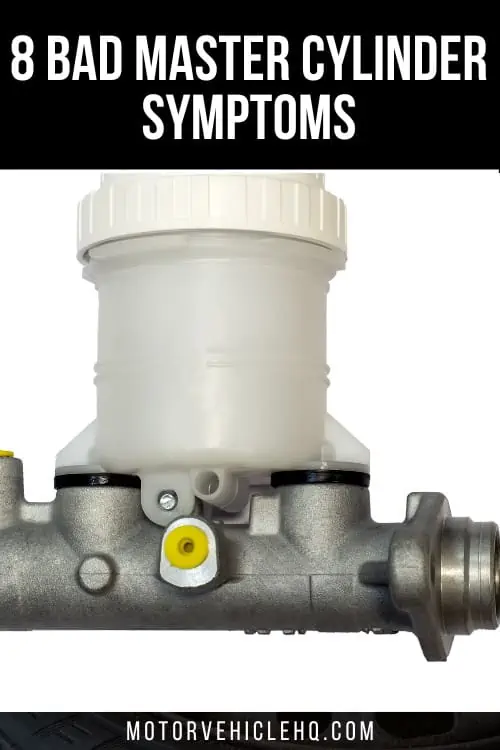

Nyangano Maurice specializes in vehicle troubleshooting and has more than 10 years of experience in the automobile industry. Over many years of experience as a car mechanic, he has acquired a broad range of skills, including engine repair, brake systems, electrical systems, and more. He frequently hosts community workshops and training programs to help motor vehicle owners understand their vehicles better.
